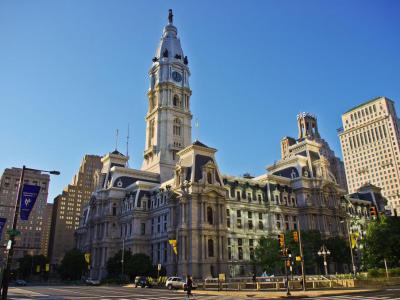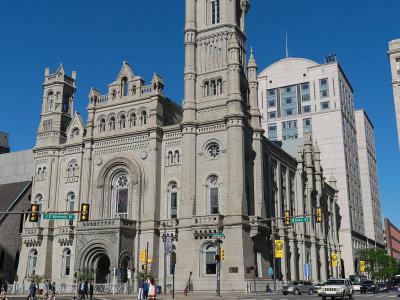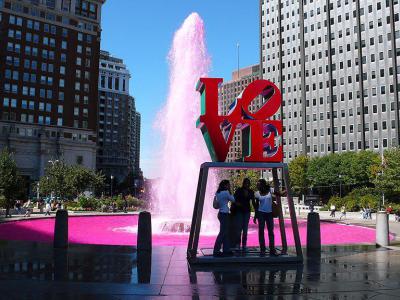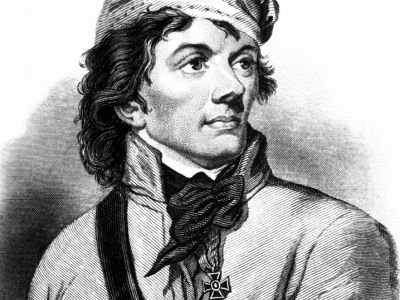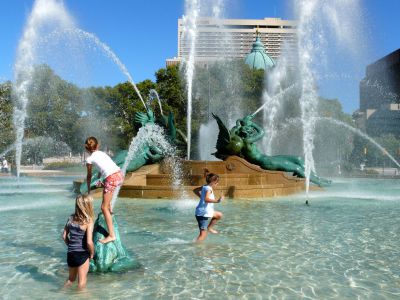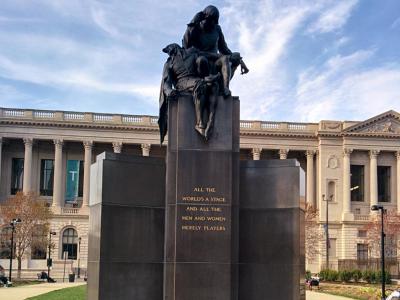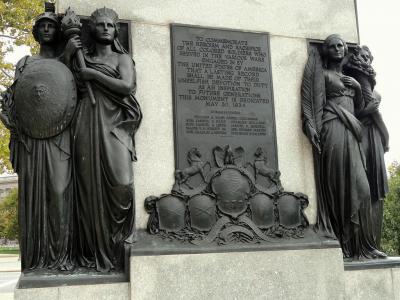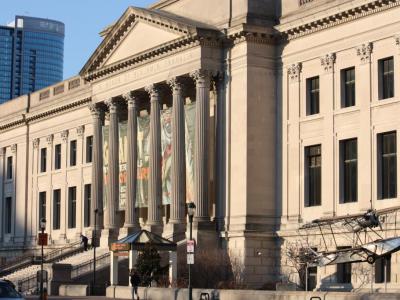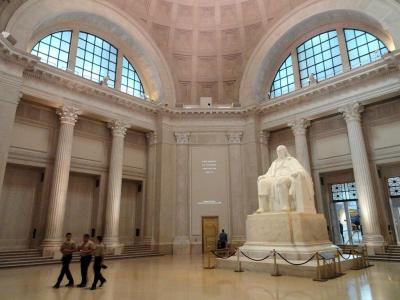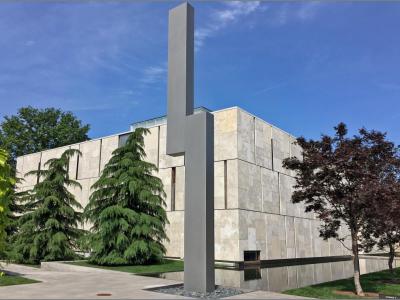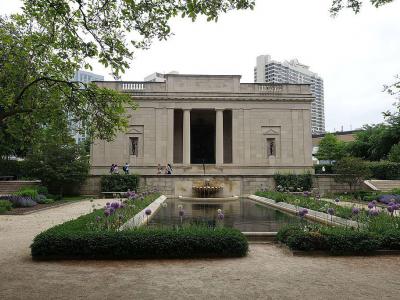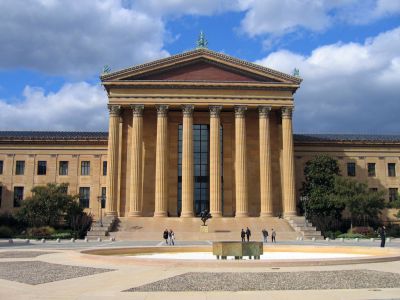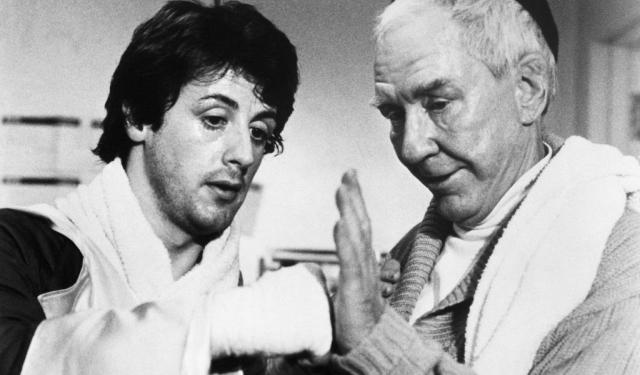Franklin Parkway Walking Tour (Self Guided), Philadelphia
Benjamin Franklin Parkway is a scenic boulevard running through the cultural heart of Philadelphia. Named for America's Founding Father, Benjamin Franklin, this mile-long tree-lined parkway is lined with several notable sights and world-class museums.
At its heart lies Logan Circle, a charming green space centered around a picturesque fountain. This spot can provide a refreshing break on a hot summer day.
As you stroll along Franklin Parkway, you'll inevitably come across the Shakespeare Memorial, a tribute to the renowned English playwright.
Further down the road, proudly stands the All Wars Memorial to Colored Soldiers and Sailors. This solemn monument honors the bravery and sacrifice of African American soldiers and sailors who served in various conflicts throughout American history.
One of the parkway's highlights is the Franklin Institute Science Museum – a great destination for those interested in hands-on exhibits and engaging displays.
Nearby, you will find the Benjamin Franklin National Memorial, which pays homage to one of the Founding Fathers and a key figure in American history.
Art enthusiasts can explore the Barnes Foundation and the Rodin Museum, both housing impressive collections of art and sculpture. These cultural institutions offer a unique and enriching experience for visitors, making them must-visit locations on the parkway.
The grand finale of your journey leads you to the iconic Philadelphia Museum of Art. Known for the famous "Rocky Steps" and its vast art collections, this cultural gem captivates art lovers and admirers of the city alike.
In essence, Franklin Parkway is a treasure trove of culture, history, and art in Philadelphia. So, follow this self-guided walk to appreciate its remarkable landmarks on your next trip to the city. Franklin Parkway promises an exciting adventure!
At its heart lies Logan Circle, a charming green space centered around a picturesque fountain. This spot can provide a refreshing break on a hot summer day.
As you stroll along Franklin Parkway, you'll inevitably come across the Shakespeare Memorial, a tribute to the renowned English playwright.
Further down the road, proudly stands the All Wars Memorial to Colored Soldiers and Sailors. This solemn monument honors the bravery and sacrifice of African American soldiers and sailors who served in various conflicts throughout American history.
One of the parkway's highlights is the Franklin Institute Science Museum – a great destination for those interested in hands-on exhibits and engaging displays.
Nearby, you will find the Benjamin Franklin National Memorial, which pays homage to one of the Founding Fathers and a key figure in American history.
Art enthusiasts can explore the Barnes Foundation and the Rodin Museum, both housing impressive collections of art and sculpture. These cultural institutions offer a unique and enriching experience for visitors, making them must-visit locations on the parkway.
The grand finale of your journey leads you to the iconic Philadelphia Museum of Art. Known for the famous "Rocky Steps" and its vast art collections, this cultural gem captivates art lovers and admirers of the city alike.
In essence, Franklin Parkway is a treasure trove of culture, history, and art in Philadelphia. So, follow this self-guided walk to appreciate its remarkable landmarks on your next trip to the city. Franklin Parkway promises an exciting adventure!
How it works: Download the app "GPSmyCity: Walks in 1K+ Cities" from Apple App Store or Google Play Store to your mobile phone or tablet. The app turns your mobile device into a personal tour guide and its built-in GPS navigation functions guide you from one tour stop to next. The app works offline, so no data plan is needed when traveling abroad.
Franklin Parkway Walking Tour Map
Guide Name: Franklin Parkway Walking Tour
Guide Location: USA » Philadelphia (See other walking tours in Philadelphia)
Guide Type: Self-guided Walking Tour (Sightseeing)
# of Attractions: 12
Tour Duration: 2 Hour(s)
Travel Distance: 2.6 Km or 1.6 Miles
Author: leticia
Sight(s) Featured in This Guide:
Guide Location: USA » Philadelphia (See other walking tours in Philadelphia)
Guide Type: Self-guided Walking Tour (Sightseeing)
# of Attractions: 12
Tour Duration: 2 Hour(s)
Travel Distance: 2.6 Km or 1.6 Miles
Author: leticia
Sight(s) Featured in This Guide:
- Philadelphia City Hall
- Masonic Temple
- LOVE Park
- Thaddeus Kosciuszko Statue
- Logan Circle
- Shakespeare Memorial
- All Wars Memorial to Colored Soldiers and Sailors
- The Franklin Institute Science Museum
- Benjamin Franklin National Memorial
- Barnes Foundation
- Rodin Museum
- Philadelphia Museum of Art
1) Philadelphia City Hall
King Charles II owed a hefty sum of money to Admiral Sir William Penn, to wit 16,000 pounds. To discharge the debt, on 4 March 1681, the King signed a charter granting what is now Pennsylvania to the Admiral's son, William. William the Younger was a radical Quaker filled with democratic ideals. He set out for America.
Center Square was one of the original five squares marked out by Penn as the center of his city. It was simply a public square until the building of City Hall in 1871. By that time, it had come to be called Penn Square.
Located at number 1 Penn Square, City Hall was designed by architect John McArthur in the Second Empire style. It was in the process of construction from 1871 until 1901. Upon its completion, the Hall was the world's tallest habitable building.
The City Hall is a masonry building supported by brick and granite walls up to 22 feet thick. The outside walls are mainly limestone, granite, and marble. Sculptor Alexander Milne Calder created over 250 sculptured images of American ideals. With nearly 700 rooms, the Hall is the largest civic building in the country with the tallest clock tower in the world.
The tall clock tower has a clock face on each side. Four bronze eagles are perched above the clocks. A giant bronze statue of William Penn by Calder is at the top of the tower. Beneath the monument is a glass-enclosed observation deck.
Center Square was one of the original five squares marked out by Penn as the center of his city. It was simply a public square until the building of City Hall in 1871. By that time, it had come to be called Penn Square.
Located at number 1 Penn Square, City Hall was designed by architect John McArthur in the Second Empire style. It was in the process of construction from 1871 until 1901. Upon its completion, the Hall was the world's tallest habitable building.
The City Hall is a masonry building supported by brick and granite walls up to 22 feet thick. The outside walls are mainly limestone, granite, and marble. Sculptor Alexander Milne Calder created over 250 sculptured images of American ideals. With nearly 700 rooms, the Hall is the largest civic building in the country with the tallest clock tower in the world.
The tall clock tower has a clock face on each side. Four bronze eagles are perched above the clocks. A giant bronze statue of William Penn by Calder is at the top of the tower. Beneath the monument is a glass-enclosed observation deck.
2) Masonic Temple
The Masonic Temple of Philadelphia is located at 1 North Broad Street, across the Philadelphia City Hall, and serves as the headquarters of the Grand Lodge of Pennsylvania. The Temple holds the Masonic Library and Museum of Philadelphia. The Temple welcomes thousands of visitors every year. In its seven lodge rooms, the Philadelphia lodges and the Grand Lodge conduct their meetings.
The Masonic Temple was designed in the medieval Norman building style by architect James H. Windrim. The enormous 10-ton granite cornerstone was laid in June 1868. Grand Master Richard Vaux used the same gavel that day used by George Washington to level the cornerstone of the Capitol in 1793.
The interior, which took 15 years to finish, was mainly designed by the decorative painter George Herzog. The stylistic elements of the Middle Ages meld into a fantasy of Renaissance and Neo-classicism in the halls and a 19th-century "eclectic revivalism" in the lodge rooms.
On the first floor are the Oriental Hall and the Library and Museum, the Grand Banquet Hall, the Grand Master's Suite, and offices. Norman, Egyptian, Ionic, Corinthian, and Renaissance Halls share the second floor. On the third floor is Gothic Hall. Ornate corridors and stairways connect every room.
The Masonic Temple was designed in the medieval Norman building style by architect James H. Windrim. The enormous 10-ton granite cornerstone was laid in June 1868. Grand Master Richard Vaux used the same gavel that day used by George Washington to level the cornerstone of the Capitol in 1793.
The interior, which took 15 years to finish, was mainly designed by the decorative painter George Herzog. The stylistic elements of the Middle Ages meld into a fantasy of Renaissance and Neo-classicism in the halls and a 19th-century "eclectic revivalism" in the lodge rooms.
On the first floor are the Oriental Hall and the Library and Museum, the Grand Banquet Hall, the Grand Master's Suite, and offices. Norman, Egyptian, Ionic, Corinthian, and Renaissance Halls share the second floor. On the third floor is Gothic Hall. Ornate corridors and stairways connect every room.
3) LOVE Park
LOVE Park, officially named John F. Kennedy Plaza, is a notable public park in Center City, Philadelphia. It is renowned for its reproduction of Robert Indiana's LOVE sculpture, which has become an iconic feature overlooking the plaza. The park's nickname, "LOVE Park," is derived from this sculpture.
The park's design was the brainchild of former Philadelphia city planner Edmund Bacon and architect Vincent G. Kling. It was established in 1965, covering an underground parking garage. The park's central attraction is a single-spout fountain, added in 1969, which quickly became its main feature.
Located directly across from the Philadelphia City Hall, LOVE Park serves as a visual terminus for the Benjamin Franklin Parkway. It was dedicated in 1967 as John F. Kennedy Plaza, and a plaque within the park commemorates this dedication.
LOVE Park is also significant in the skateboarding community. For many years, it was a popular skateboarding spot, contributing to its cultural significance.
The famous "LOVE" sculpture by Robert Indiana first graced the plaza in 1976 as part of the United States Bicentennial celebration. Initially, the sculpture was temporary and removed in 1978. However, thanks to the efforts of Fitz Eugene Dixon Jr., chairman of the Philadelphia Art Commission, the sculpture was purchased and permanently installed in the park that same year.
From 2016 to 2018, LOVE Park underwent a major makeover, turning the concrete-heavy plaza into a greener and friendlier space. The project added lawns, gardens, stormwater basins with diverse plants, new café areas, and recreational spaces, all while preserving the view of City Hall and the Benjamin Franklin Parkway. This transformation reflects modern urban park design trends, marking a new era for the park.
The park's design was the brainchild of former Philadelphia city planner Edmund Bacon and architect Vincent G. Kling. It was established in 1965, covering an underground parking garage. The park's central attraction is a single-spout fountain, added in 1969, which quickly became its main feature.
Located directly across from the Philadelphia City Hall, LOVE Park serves as a visual terminus for the Benjamin Franklin Parkway. It was dedicated in 1967 as John F. Kennedy Plaza, and a plaque within the park commemorates this dedication.
LOVE Park is also significant in the skateboarding community. For many years, it was a popular skateboarding spot, contributing to its cultural significance.
The famous "LOVE" sculpture by Robert Indiana first graced the plaza in 1976 as part of the United States Bicentennial celebration. Initially, the sculpture was temporary and removed in 1978. However, thanks to the efforts of Fitz Eugene Dixon Jr., chairman of the Philadelphia Art Commission, the sculpture was purchased and permanently installed in the park that same year.
From 2016 to 2018, LOVE Park underwent a major makeover, turning the concrete-heavy plaza into a greener and friendlier space. The project added lawns, gardens, stormwater basins with diverse plants, new café areas, and recreational spaces, all while preserving the view of City Hall and the Benjamin Franklin Parkway. This transformation reflects modern urban park design trends, marking a new era for the park.
4) Thaddeus Kosciuszko Statue
The Thaddeus Kosciuszko Statue in Philadelphia, dedicated on July 3, 1979, symbolizes the enduring friendship and shared values between Poland and the United States. It honors General Thaddeus Kosciuszko, a Polish patriot and American Revolutionary War hero. The monument was presented as the official Bicentennial gift from Poland to the United States, in celebration of the 200th anniversary of American Independence.
Thaddeus Kosciuszko, born into a wealthy Polish family, received his early military education in Warsaw, followed by engineering studies in France. In 1777, he arrived in America, where he offered his expertise to the American colonists fighting for independence from British rule. Kosciuszko's contributions were pivotal, particularly in fortifying Philadelphia, securing a crucial victory at Saratoga, and designing the fortifications at West Point. Honored by Congress in 1783, he received citizenship, land, a pension, and the rank of Brigadier General before leaving for Europe in 1784.
Kosciuszko's dedication to freedom went beyond his American service. In 1789, he became a Major General in the Polish Army, leading the 1794 uprising against Russian control. Though captured and imprisoned in Saint Petersburg, he was released two years later. In 1797, he returned to the US, then settled in France to support Polish independence. He passed away in Switzerland, and his remains were moved to Cracow in 1818.
The monument in Philadelphia not only honors Kosciuszko's military and engineering feats but also celebrates his unwavering dedication to liberty and justice. His last residence in America, located at 301 Pine Street in Philadelphia, was declared a national memorial in 1976, further cementing his legacy in the fabric of American history and heritage.
Thaddeus Kosciuszko, born into a wealthy Polish family, received his early military education in Warsaw, followed by engineering studies in France. In 1777, he arrived in America, where he offered his expertise to the American colonists fighting for independence from British rule. Kosciuszko's contributions were pivotal, particularly in fortifying Philadelphia, securing a crucial victory at Saratoga, and designing the fortifications at West Point. Honored by Congress in 1783, he received citizenship, land, a pension, and the rank of Brigadier General before leaving for Europe in 1784.
Kosciuszko's dedication to freedom went beyond his American service. In 1789, he became a Major General in the Polish Army, leading the 1794 uprising against Russian control. Though captured and imprisoned in Saint Petersburg, he was released two years later. In 1797, he returned to the US, then settled in France to support Polish independence. He passed away in Switzerland, and his remains were moved to Cracow in 1818.
The monument in Philadelphia not only honors Kosciuszko's military and engineering feats but also celebrates his unwavering dedication to liberty and justice. His last residence in America, located at 301 Pine Street in Philadelphia, was declared a national memorial in 1976, further cementing his legacy in the fabric of American history and heritage.
5) Logan Circle
Logan Circle, also known as Logan Square, is an open-space park located in the northwest quadrant of Center City Philadelphia. It holds a special place in the city's layout as one of the five original squares planned in the city grid. This park is not just a green space but also a historic area, having been part of William Penn's original 1684 plan for Philadelphia. Originally named "Northwest Square," it was renamed in 1825 to honor James Logan, a prominent Philadelphia statesman.
The park's most striking feature is the Logan Circle, a beautifully designed circular area that features a large water fountain. This circle is the centerpiece of the park and is surrounded by a traffic circle that carries 19th Street and the Benjamin Franklin Parkway. These roads provide connections to 18th and 20th Streets on the east and west, and Race and Vine Streets to the south and north. The circle is situated within the original boundaries of the square, which is why the terms Logan Square and Logan Circle are often used interchangeably when referring to the park.
Logan Square is not just a place of beauty and history but also the heart of its namesake neighborhood, playing a central role in the community. In recognition of its historical and cultural significance, Logan Square was added to the National Register of Historic Places in 1981, underlining its importance not only to Philadelphia but also as a part of national heritage.
The park's most striking feature is the Logan Circle, a beautifully designed circular area that features a large water fountain. This circle is the centerpiece of the park and is surrounded by a traffic circle that carries 19th Street and the Benjamin Franklin Parkway. These roads provide connections to 18th and 20th Streets on the east and west, and Race and Vine Streets to the south and north. The circle is situated within the original boundaries of the square, which is why the terms Logan Square and Logan Circle are often used interchangeably when referring to the park.
Logan Square is not just a place of beauty and history but also the heart of its namesake neighborhood, playing a central role in the community. In recognition of its historical and cultural significance, Logan Square was added to the National Register of Historic Places in 1981, underlining its importance not only to Philadelphia but also as a part of national heritage.
6) Shakespeare Memorial
The Shakespeare Memorial in Philadelphia stands as a testament to the city's appreciation of the Bard's literary genius. Conceived in 1892 by artist John Sartain, a member of the Fairmount Park Art Association (now known as the Association for Public Art), the idea was to honor William Shakespeare through a monument funded by public and private subscriptions. However, it wasn't until the 300th anniversary of Shakespeare's death in 1916 that this concept gained significant momentum, highlighting Philadelphia's need for a Shakespearean tribute.
By 1917, sufficient funds had been raised for the memorial. The development of the Benjamin Franklin Parkway during this time led to the commissioning of Alexander Stirling Calder for the project. Calder, renowned for his other local works such as the Swann Memorial Fountain and the Calder Statues, was chosen to bring this vision to life.
The original location for the memorial was in front of the Free Library. The sculpture was cast in 1926 by the Roman Bronze Works and was officially dedicated on April 23, 1929, coinciding with Shakespeare’s birthday. However, due to expressway construction, the memorial was relocated in 1953 to its current position.
The sculpture itself is a poignant representation of Shakespeare's themes of Comedy and Tragedy. It features two figures: Hamlet, depicted in a moment of introspection with his head resting against a knife, and Touchstone, the jester from "As You Like It," captured in a moment of laughter at Hamlet's feet. The base of the sculpture bears the famous quote from "As You Like It": “All the world’s a stage and all the men and women merely players,” encapsulating the essence of Shakespeare's perception of life and human experience.
By 1917, sufficient funds had been raised for the memorial. The development of the Benjamin Franklin Parkway during this time led to the commissioning of Alexander Stirling Calder for the project. Calder, renowned for his other local works such as the Swann Memorial Fountain and the Calder Statues, was chosen to bring this vision to life.
The original location for the memorial was in front of the Free Library. The sculpture was cast in 1926 by the Roman Bronze Works and was officially dedicated on April 23, 1929, coinciding with Shakespeare’s birthday. However, due to expressway construction, the memorial was relocated in 1953 to its current position.
The sculpture itself is a poignant representation of Shakespeare's themes of Comedy and Tragedy. It features two figures: Hamlet, depicted in a moment of introspection with his head resting against a knife, and Touchstone, the jester from "As You Like It," captured in a moment of laughter at Hamlet's feet. The base of the sculpture bears the famous quote from "As You Like It": “All the world’s a stage and all the men and women merely players,” encapsulating the essence of Shakespeare's perception of life and human experience.
7) All Wars Memorial to Colored Soldiers and Sailors
The All Wars Memorial to Colored Soldiers and Sailors in Philadelphia is a war memorial dedicated to honoring African American servicemen from Pennsylvania who participated in American conflicts ranging from the American Revolutionary War to World War I. This memorial was crafted by the sculptor J. Otto Schweizer and officially dedicated on July 7, 1934. In 1994, it was relocated from West Fairmount Park to a more prominent spot along Benjamin Franklin Parkway in Logan Square.
The structure of the monument is impressive in size, standing approximately 21.5 feet (6.55 meters) tall, and rests on a base that is about 17 feet (5.18 meters) wide and 13.5 feet (4.11 meters) deep. Constructed primarily from granite, the monument features bronze sculptures as integral parts of its design.
The front side of the monument is adorned with a "conspicuously Caucasian" female figure representing Justice, who is depicted holding a laurel wreath in each hand, symbolizing Honor and Reward. Accompanying this figure are military personnel, with two soldiers and a sailor on her right, and three soldiers on her left, all donned in World War I uniforms.
In contrast, the reverse side of the monument showcases four Caucasian female figures embodying War, Liberty, Peace, and Plenty. Additionally, this side includes a dedication plaque and a bas-relief of the Seal of Pennsylvania. The monument is topped with four American eagles, symbolically guarding The Torch of Life. Each of the bronze figures incorporated in the memorial is approximately 6 feet (1.83 meters) tall.
The All Wars Memorial to Colored Soldiers and Sailors stands as a poignant tribute to the contributions and sacrifices of African American servicemen in the history of the United States military.
The structure of the monument is impressive in size, standing approximately 21.5 feet (6.55 meters) tall, and rests on a base that is about 17 feet (5.18 meters) wide and 13.5 feet (4.11 meters) deep. Constructed primarily from granite, the monument features bronze sculptures as integral parts of its design.
The front side of the monument is adorned with a "conspicuously Caucasian" female figure representing Justice, who is depicted holding a laurel wreath in each hand, symbolizing Honor and Reward. Accompanying this figure are military personnel, with two soldiers and a sailor on her right, and three soldiers on her left, all donned in World War I uniforms.
In contrast, the reverse side of the monument showcases four Caucasian female figures embodying War, Liberty, Peace, and Plenty. Additionally, this side includes a dedication plaque and a bas-relief of the Seal of Pennsylvania. The monument is topped with four American eagles, symbolically guarding The Torch of Life. Each of the bronze figures incorporated in the memorial is approximately 6 feet (1.83 meters) tall.
The All Wars Memorial to Colored Soldiers and Sailors stands as a poignant tribute to the contributions and sacrifices of African American servicemen in the history of the United States military.
8) The Franklin Institute Science Museum (must see)
The Franklin Institute Science Museum, named in honor of the renowned American scientist and statesman Benjamin Franklin, stands as a hallmark of science education and development in the United States. Established in 1824, it is one of the country's oldest institutions dedicated to science. Located in Philadelphia, the museum also includes the esteemed Benjamin Franklin National Memorial.
The Science Center within the museum caters to a diverse audience, offering exhibitions that appeal to both adults and children. The first floor is particularly notable for its focus on space and includes a Planetarium, providing an immersive experience into the wonders of the cosmos. On the second floor, visitors will find a gift shop along with two interactive and educational exhibits, one about the brain and the other about the heart, both designed to be engaging and informative. The third floor takes a deep dive into the world of inventions and machines, featuring fun educational games that illuminate the creative process behind technological advancements. For those interested in astronomy, the fourth floor houses an observatory equipped with a large telescope, offering a closer look at the night sky.
Adding to the museum's historical significance is the Budd BB-1 Pioneer, displayed prominently in front of the museum. This aircraft, notable for being the first stainless steel airplane, was built by the Edward F. Budd Manufacturing Corporation and has been a part of the museum's exhibit since 1935.
Furthermore, The Franklin Institute is renowned for its longstanding commitment to recognizing excellence in science and technology. Since its inception in 1824, it has administered the longest continuously awarded science and technology awards program in the United States and one of the oldest globally. This tradition underscores the institute's ongoing dedication to fostering scientific inquiry and education.
The Science Center within the museum caters to a diverse audience, offering exhibitions that appeal to both adults and children. The first floor is particularly notable for its focus on space and includes a Planetarium, providing an immersive experience into the wonders of the cosmos. On the second floor, visitors will find a gift shop along with two interactive and educational exhibits, one about the brain and the other about the heart, both designed to be engaging and informative. The third floor takes a deep dive into the world of inventions and machines, featuring fun educational games that illuminate the creative process behind technological advancements. For those interested in astronomy, the fourth floor houses an observatory equipped with a large telescope, offering a closer look at the night sky.
Adding to the museum's historical significance is the Budd BB-1 Pioneer, displayed prominently in front of the museum. This aircraft, notable for being the first stainless steel airplane, was built by the Edward F. Budd Manufacturing Corporation and has been a part of the museum's exhibit since 1935.
Furthermore, The Franklin Institute is renowned for its longstanding commitment to recognizing excellence in science and technology. Since its inception in 1824, it has administered the longest continuously awarded science and technology awards program in the United States and one of the oldest globally. This tradition underscores the institute's ongoing dedication to fostering scientific inquiry and education.
9) Benjamin Franklin National Memorial
The Benjamin Franklin National Memorial, a significant monument to one of America's most illustrious figures, is located within the rotunda of the Franklin Institute science museum in Philadelphia. This monumental site features a grand statue of Benjamin Franklin, renowned as an American writer, inventor, statesman, and one of the Founding Fathers. Crafted by James Earle Fraser, the statue stands impressively at 20 feet (approximately 6.1 meters) in height. Fraser worked on this project from 1906 to 1911, with the memorial being officially dedicated in 1938.
This enormous statue weighs about 30 short tons and is perched on a pedestal made from white Seravezza marble, itself weighing 92 short tons. The statue is the centerpiece of Memorial Hall in the Franklin Institute, an architectural wonder designed by John Windrim and inspired by the Roman Pantheon.
Significant enhancements were made to the memorial in 2008. These improvements included a restoration project that saw the introduction of a multi-media presentation, titled "Benjamin Franklin Forever." This 3½-minute show leverages digital projection, theatrical lighting, and audio effects to celebrate Franklin's legacy.
Additionally, the refurbishment enhanced the acoustics and incorporated state-of-the-art LED lighting. The oculus of the memorial was also restored and re-gilded to its original splendor. An engaging aspect of the memorial is the projection of Franklin's quotes onto the walls throughout the day.
This enormous statue weighs about 30 short tons and is perched on a pedestal made from white Seravezza marble, itself weighing 92 short tons. The statue is the centerpiece of Memorial Hall in the Franklin Institute, an architectural wonder designed by John Windrim and inspired by the Roman Pantheon.
Significant enhancements were made to the memorial in 2008. These improvements included a restoration project that saw the introduction of a multi-media presentation, titled "Benjamin Franklin Forever." This 3½-minute show leverages digital projection, theatrical lighting, and audio effects to celebrate Franklin's legacy.
Additionally, the refurbishment enhanced the acoustics and incorporated state-of-the-art LED lighting. The oculus of the memorial was also restored and re-gilded to its original splendor. An engaging aspect of the memorial is the projection of Franklin's quotes onto the walls throughout the day.
10) Barnes Foundation (must see)
The Barnes Foundation, situated in Philadelphia, is a renowned art collection and educational institution dedicated to fostering an appreciation for art and horticulture. Founded in 1922 by Albert C. Barnes, who gained wealth from co-developing Argyrol, an antiseptic silver compound, the Barnes Foundation has a rich history. Barnes, known for his business savvy, sold A.C. Barnes Company before the 1929 stock market crash. He initially founded the Foundation in Merion, but in 2012, the collection moved to a new facility on Benjamin Franklin Parkway in Philadelphia.
Today, the Barnes Foundation is home to an extraordinary collection, encompassing over 4,000 objects. This includes a remarkable array of over 900 paintings, with an estimated value of around $25 billion. The collection is particularly noted for its extensive array of works by Impressionist, Post-Impressionist, and Modernist masters. This includes a significant number of pieces by Renoir, Cezanne, Picasso, along with a specially commissioned large mural by Henri Matisse, made explicitly for The Barnes. Beyond these, the collection is also rich in other European and American paintings, showcasing the breadth and diversity of art history.
Moreover, the Barnes Foundation's collection extends beyond these well-known Western artworks. It also houses a significant compilation of African art, antiquities from ancient civilizations such as China, Egypt, and Greece, and Native American art, reflecting a global perspective and a deep appreciation for various artistic expressions across cultures and time periods. The Foundation, thus, stands as a testament to the vision of Albert C. Barnes and continues to be a pivotal institution in the world of art and education.
Today, the Barnes Foundation is home to an extraordinary collection, encompassing over 4,000 objects. This includes a remarkable array of over 900 paintings, with an estimated value of around $25 billion. The collection is particularly noted for its extensive array of works by Impressionist, Post-Impressionist, and Modernist masters. This includes a significant number of pieces by Renoir, Cezanne, Picasso, along with a specially commissioned large mural by Henri Matisse, made explicitly for The Barnes. Beyond these, the collection is also rich in other European and American paintings, showcasing the breadth and diversity of art history.
Moreover, the Barnes Foundation's collection extends beyond these well-known Western artworks. It also houses a significant compilation of African art, antiquities from ancient civilizations such as China, Egypt, and Greece, and Native American art, reflecting a global perspective and a deep appreciation for various artistic expressions across cultures and time periods. The Foundation, thus, stands as a testament to the vision of Albert C. Barnes and continues to be a pivotal institution in the world of art and education.
11) Rodin Museum (must see)
The Rodin Museum, situated in Philadelphia, is an art museum that boasts one of the largest collections of the renowned sculptor Auguste Rodin's creations outside of Paris.
The museum was established as a gift to the city of Philadelphia by Jules Mastbaum (1872–1926), a prominent figure in the movie theater industry. In 1923, Mastbaum embarked on a mission to collect Rodin's works with the goal of creating a museum to enhance the cultural life of the city's residents. In just three years, he managed to assemble an impressive collection of Rodin's pieces, including bronze sculptures, plaster studies, drawings, prints, letters, and books. In 1926, Mastbaum enlisted the services of French architects Paul Cret and Jacques Gréber to design the museum building and its surrounding gardens. Unfortunately, Mastbaum did not live to see his vision come to fruition, but his widow, Etta Wedell Mastbaum, upheld his commitment to the city, and the museum officially opened its doors on November 29, 1929. Notably, the museum features murals created by the painter Franklin C. Watkins.
Prominently displayed in the museum's entry courtyard is one of Rodin's most famous works, "The Thinker" (1880–1882). Previously, visitors would enter through a replica of "The Gates of Hell," situated at the main entrance, which is no longer in use. This colossal bronze doorway, standing at a height of 5.5 meters, was initially conceived for the Museum of Decorative Arts, originally intended for Paris but never realized. Rodin meticulously sculpted over 100 figures for these doors from 1880 until his passing in 1917. The casting on display at the Rodin Museum is one of only three originals. Several of Rodin's iconic pieces, including "The Thinker," were initially conceived as studies for these doors and later evolved into independent works of art.
Throughout the museum's various rooms, visitors can explore a diverse array of Rodin's creations, including notable pieces such as "The Kiss" (1886), "Eternal Springtime" (1884), "The Age of Bronze" (1875–76), and "The Burghers of Calais," a monument commissioned by the City of Calais in 1884.
The museum was established as a gift to the city of Philadelphia by Jules Mastbaum (1872–1926), a prominent figure in the movie theater industry. In 1923, Mastbaum embarked on a mission to collect Rodin's works with the goal of creating a museum to enhance the cultural life of the city's residents. In just three years, he managed to assemble an impressive collection of Rodin's pieces, including bronze sculptures, plaster studies, drawings, prints, letters, and books. In 1926, Mastbaum enlisted the services of French architects Paul Cret and Jacques Gréber to design the museum building and its surrounding gardens. Unfortunately, Mastbaum did not live to see his vision come to fruition, but his widow, Etta Wedell Mastbaum, upheld his commitment to the city, and the museum officially opened its doors on November 29, 1929. Notably, the museum features murals created by the painter Franklin C. Watkins.
Prominently displayed in the museum's entry courtyard is one of Rodin's most famous works, "The Thinker" (1880–1882). Previously, visitors would enter through a replica of "The Gates of Hell," situated at the main entrance, which is no longer in use. This colossal bronze doorway, standing at a height of 5.5 meters, was initially conceived for the Museum of Decorative Arts, originally intended for Paris but never realized. Rodin meticulously sculpted over 100 figures for these doors from 1880 until his passing in 1917. The casting on display at the Rodin Museum is one of only three originals. Several of Rodin's iconic pieces, including "The Thinker," were initially conceived as studies for these doors and later evolved into independent works of art.
Throughout the museum's various rooms, visitors can explore a diverse array of Rodin's creations, including notable pieces such as "The Kiss" (1886), "Eternal Springtime" (1884), "The Age of Bronze" (1875–76), and "The Burghers of Calais," a monument commissioned by the City of Calais in 1884.
12) Philadelphia Museum of Art
The Philadelphia Museum of Art, with its roots dating back to 1876 as part of the Centennial Exposition in Philadelphia, stands as a significant cultural landmark. The main building, completed in 1928 on Fairmount, crowns the northwest end of the Benjamin Franklin Parkway at Eakins Oval. This prestigious institution is renowned for its expansive collection, which encompasses over 240,000 objects. The collection's diversity is impressive, featuring major works of European, American, and Asian origin across various mediums such as sculpture, paintings, prints, drawings, photographs, armor, and decorative arts.
Beyond its main building, the museum extends its reach through several annexes. Notably, the Rodin Museum, also situated on the Benjamin Franklin Parkway, and the Ruth and Raymond G. Perelman Building, located just north across the street from the main building, expand the museum's offerings. The Perelman Building, opened in 2007, is particularly notable for housing an extensive collection of over 150,000 prints, drawings, and photographs, along with 30,000 costume and textile items, and more than 1,000 modern and contemporary design objects, including furniture, ceramics, and glasswork.
The museum's scope extends to the historic colonial-era houses of Mount Pleasant and Cedar Grove, both nestled within Fairmount Park. These houses add a historical dimension to the museum's diverse portfolio. Owned by the City of Philadelphia, the main museum building and its annexes are managed by a registered nonprofit corporation. The museum is not just a repository of art but also a vibrant center for cultural exchange, hosting several special exhibitions each year. These include touring exhibitions in collaboration with other museums both in the United States and internationally.
Beyond its main building, the museum extends its reach through several annexes. Notably, the Rodin Museum, also situated on the Benjamin Franklin Parkway, and the Ruth and Raymond G. Perelman Building, located just north across the street from the main building, expand the museum's offerings. The Perelman Building, opened in 2007, is particularly notable for housing an extensive collection of over 150,000 prints, drawings, and photographs, along with 30,000 costume and textile items, and more than 1,000 modern and contemporary design objects, including furniture, ceramics, and glasswork.
The museum's scope extends to the historic colonial-era houses of Mount Pleasant and Cedar Grove, both nestled within Fairmount Park. These houses add a historical dimension to the museum's diverse portfolio. Owned by the City of Philadelphia, the main museum building and its annexes are managed by a registered nonprofit corporation. The museum is not just a repository of art but also a vibrant center for cultural exchange, hosting several special exhibitions each year. These include touring exhibitions in collaboration with other museums both in the United States and internationally.
Walking Tours in Philadelphia, Pennsylvania
Create Your Own Walk in Philadelphia
Creating your own self-guided walk in Philadelphia is easy and fun. Choose the city attractions that you want to see and a walk route map will be created just for you. You can even set your hotel as the start point of the walk.
Rocky Movie Sites Walking Tour
There's hardly any other character, fictional or real, as iconically Philadelphian as Rocky. Indeed, this American sports drama franchise, centered on the boxing career of Rocky Balboa, released in 1976, has become synonymous with and arguably done more for the city of Philadelphia than anyone else since Ben Franklin.
The cultural phenomenon was created by Sylvester Stallone, who wrote,... view more
Tour Duration: 3 Hour(s)
Travel Distance: 6.3 Km or 3.9 Miles
The cultural phenomenon was created by Sylvester Stallone, who wrote,... view more
Tour Duration: 3 Hour(s)
Travel Distance: 6.3 Km or 3.9 Miles
University of Pennsylvania Walking Tour
As America's first university, The University of Pennsylvania (aka Penn or Upenn, for short) has a history stretching back to the mid-18th century, closely bound with the city's colonial past and the birth of the United States. Initially, this Ivy League institution emerged as the College of Philadelphia, one of the nine colonial colleges chartered before the US Declaration of... view more
Tour Duration: 2 Hour(s)
Travel Distance: 2.2 Km or 1.4 Miles
Tour Duration: 2 Hour(s)
Travel Distance: 2.2 Km or 1.4 Miles
Philadelphia Old City Walking Tour
King Charles II of England, while seriously indebted to Admiral Sir William Penn, settled his debt in 1681 by granting lands in America to William Penn, the Admiral's Quaker son. A thorn in the King's side, young Penn sailed to America, where he envisioned a utopian society based on tolerance and founded Philadelphia, the "City of Brotherly Love."
The Old City Center, the... view more
Tour Duration: 2 Hour(s)
Travel Distance: 3.2 Km or 2 Miles
The Old City Center, the... view more
Tour Duration: 2 Hour(s)
Travel Distance: 3.2 Km or 2 Miles
Philadelphia Introduction Walking Tour
The sixth largest city in the United States and the largest in the Commonwealth of Pennsylvania, Philadelphia is a dynamic city heaped with old-world charm and contemporary infrastructure. Notable for its rich history, primarily as the birthplace of "life, liberty, and the pursuit of happiness."
Often called Philly, Philadelphia is also known as the City of Brotherly Love – a... view more
Tour Duration: 2 Hour(s)
Travel Distance: 2.3 Km or 1.4 Miles
Often called Philly, Philadelphia is also known as the City of Brotherly Love – a... view more
Tour Duration: 2 Hour(s)
Travel Distance: 2.3 Km or 1.4 Miles
Fairmount Park Historical Houses Walking Tour
Fairmount Park, Philadelphia's oldest park, established since 1867, is also the city's largest municipal park, sprawling over 2,000 acres adjacent to the banks of the Schuylkill River. The park grew out of the Lemon Hill estate of Henry Pratt, whose land was originally owned by Robert Morris, signer of the Declaration of Independence.
In 1972, the park was placed on the National... view more
Tour Duration: 2 Hour(s)
Travel Distance: 4.7 Km or 2.9 Miles
In 1972, the park was placed on the National... view more
Tour Duration: 2 Hour(s)
Travel Distance: 4.7 Km or 2.9 Miles
Benjamin Franklin's Philadelphia
Benjamin Franklin's journey to becoming one of the most influential figures in Revolutionary America began when he, as a teenager, ventured from a Puritan family in Boston to Philadelphia. This city would not only become his home but also a stage for his remarkable life as a writer, printer, philosopher, postmaster, scientist, inventor, statesman, and diplomat. His life epitomizes the... view more
Tour Duration: 2 Hour(s)
Travel Distance: 2.5 Km or 1.6 Miles
Tour Duration: 2 Hour(s)
Travel Distance: 2.5 Km or 1.6 Miles
Useful Travel Guides for Planning Your Trip
Philadelphia Souvenirs: 13 Unique Gift Ideas from the City of Brotherly Love
Looking for a great gift while visiting Philadelphia? Famous for its history, arts and culture, championship sports teams, and award-winning food and drink, Philadelphia is a top-rated shopping destination. Here, you'll find an amazing selection of items to choose from - something uniquely...
The Most Popular Cities
/ view all



